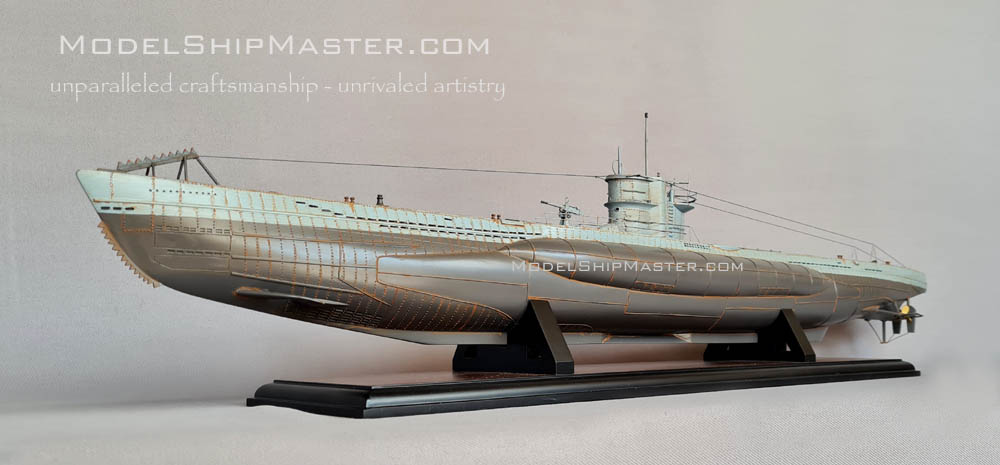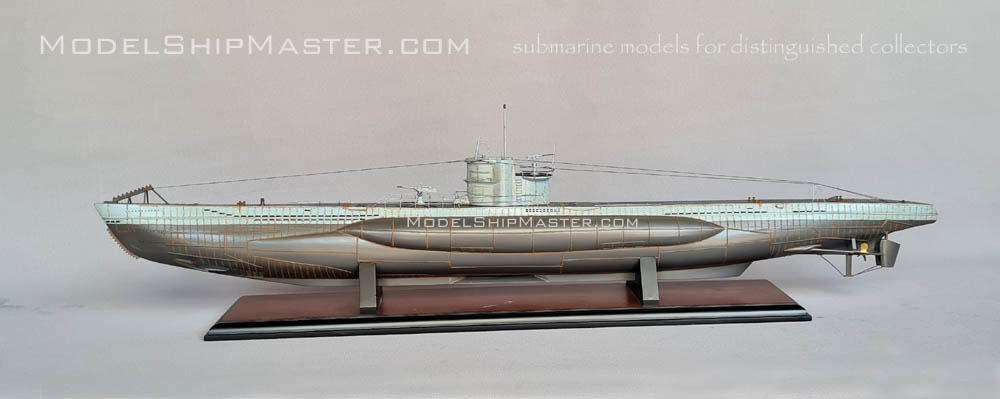|


256-bit encryption
$500,000 protection

|
U-99
submarine
Otto Kretschmer's Type VIIB U-boat
Otto Kretschmer was a famous U-Boat
commander of the Second World War, and was the most
successful Ace of the Deep. From September 1939
until being captured in March 1941, he and his U-99
submarine sank 47 ships
for a total of 274,333 tons. He earned the nickname "Silent
Otto" both for his successful use of the "silent
running" capability of the U-Boats as well as for
his reluctance to make propaganda broadcasts.

Even though Kretschmer served only three years out
of seven in WWII, he would never be surpassed in
terms of tonnage sunk. He was awarded the Iron Cross
2nd Class, the U-boat War Badge, the Iron Cross 1st
Class, the Knight's Cross, the Knight's Cross with
Oak Leaves, and the Knights Cross with Oak Leaves
and Swords.
In April 1940, after eight patrols, Kretschmer left
his U-23 for the newly-completed
Type VIIB U-99, and started his legacy.
In the first four patrols of the U-99 submarine, Kretschmer started striking convoys at night on the
surface, taking down merchant ships with highly
accurate shots, using only one torpedo per target
ship in order to save ammunition, and the quote "One
torpedo ... one ship" is attributed to Kretschmer
from around this time.

His most successful patrol occurred in
November-December 1940. During that patrol
U-99 sank three British armed
merchant cruisers, HMS Laurentic, HMS Patroclus and HMS Forfar. Put together, the
three AMCs totalled over 46,000 gross tons. These
three successes earned Kretschmer the number-one
spot on the Aces list, and was never surpassed.
On his last patrol in March 1941, he sank 10 more
ships. During a counterattack by British escorts,
U-99 was disabled by depth charges dropped from the
British destroyer HMS Walker. On March 17, Kretschmer surfaced and scuttled his boat. Three of
his men were lost. Kretschmer and the remainder crew
were captured.
Kretschmer's records:
40 ships sunk for a total of 208.869 GRT
3 auxiliary warships sunk for a total of 46.440 GRT
1 warship sunk for a total of 1.375 tons
5 ships damaged for a total of 37.965 GRT
1 ship taken as prize for a total of 2.136 GRT
2 ships a total loss for a total of 15.513 GRT
|
Wolf Pack Tactic:
The Wolf Pack or “Rudeltaktik” as the Germans called
it was made famous by Karl Donitz and was to have a
devastating impact on allied shipping. Despite being
implemented only after the fall of France, the
origins of this idea first dated back to the First
World War. During the First World War, the British
had defeated the U-boats by introducing the convoy
system. This called for the formation of a group of
ships to sail together as a group and under the
protection of escort warships. Under the convoy
system, U-boats could no longer find isolated easy
targets scattered all over. The few U-boats who
managed to find a convoy had difficulty attacking as
it was escorted by antisubmarine vessels.
The wolf pack tactic was devised to defeat the
convoy system. The idea was to form a pack of
U-boats, and to delay an attack until all boats were
in position to conduct a massed organized attack.
This would overwhelm the escorts as the sheer number
and surprise of the attacking boats would throw the
defense into disarray. The first boat to make
contact was designated as the “shadower” – whose job
was to maintain contact and to report the convoy’s
position. The
shadower would remain out of the visible range of
the convoy, often submerging by day and traveling on
the surface by night. When enough boats have
converged with the convoy, an attack started, usually after dusk where the U-boats’
small silhouette made detection difficult.
In the attack, each
individual commander was free to use any tactics. Some fired at long range, outside the
perimeter of the escorts, with a spread of
several torpedoes. Some, particularly Otto
Krteschmer headed straight into the center of
the convoy, and fired at point blank range, picking
off ship by ship as they sailed passed. Whichever
tactics employed, the general strategy was to attack
by night, and withdraw by day, with continuous
attacks lasting several days, as more boats arrived
on the scene.
This had devastating effects and easily overwhelmed the escorts. When an escort
pursued one U-boat, another would attack at a
different location, creating total chaos. Kretschmer
later wrote in his war diary
describing the attack on a convoy, “The destroyers
are at their wit’s end. Shooting off star shells the
whole time to comfort themselves and each other.”
Wolf Pack operations inflicted heavy losses.
Tonnage figures skyrocketed, and soon reached an all
time high. One of the most famous Wolf Pack attacks
took place between the nights of October 16th to the
19th, 1940. Convoy SC7 was repeatedly attacked by a
pack of seven boats, sinking 20 ships out of 34 in
the convoy. The very next night, convoy HX79 was
attacked with further losses of 14 ships, making a
total of 34 ships in 48 hours. These attacks mounted
against the two convoys became to be known as “The
Night of the Long Knives”.
Although the idea originated as early as World War
One, but many shortcomings prevented the
implementation of this tactic. First, U-boats were
dispersed far out across the oceans and Germany
lacked the powerful radio transmitters needed to
communicate with the boats. Second, there was no
governing body which was needed to co-ordinate the
attacks. After the First World War, and after Donitz had been
appointed as commander of the U-boat Force, he had
refined the Wolf Pack strategy and worked out the
theoretical elements.
In the beginning of the Second World War, the Wolf Pack tactic
still could not be implemented due to an
insufficient number of boats and the lack of
powerful radio transmitters. This, however, was to
change after the fall of France. With the collapse
of France, Germany now had control of powerful land
based transmitters on the coast of France, which
were perfectly capable of sending messages to
U-boats across the Atlantic. Also by this time, Donitz had a small fledgling of U-boats and thus was
able to begin Wolf Pack tactics from July 1940
onwards.
.jpg)
This primarily wood
model of the
U-99
submarine is
38" long. Without
rust marks
$2,940.
With rust marks
$3,540.
Shipping and insurance in
the contiguous USA included.
Other places: $350 flat rate.
Model is built per commission only. We require only a
small deposit to start the process. Not full amount, not
even half: $500  The
remaining balance won't be due until the model is
completed, in less than 6 months. The
remaining balance won't be due until the model is
completed, in less than 6 months.
ModelShipMaster builds any models, at
virtually any sizes. Contact us
now
Services@ModelShipMaser.com
to inquire.
|
|